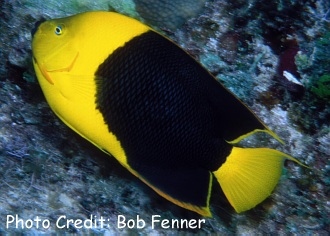
By Bob Goemans

Not Reef Tank Suitable
Likely Fish-Only Tank Suitable
Range: Western Atlantic Ocean: Gulf of Mexico, Florida, Bermuda, Bahamas and most of the Caribbean
Size: 8 inches (20 cm)
Natural Environment: Inhabits various depth areas from shallow reef waters to deep fore-reef terraces and drop-offs at depths between 10 to 300 feet (3 – 90 m). Juveniles basically stay in the shallower areas and adults in deeper waters that have concentrated sponge growths. Feeds primarily on sponges, yet also some tunicates and algae.
General Husbandry: Both the juvenile and adult are quite pretty, with the juvenile having a yellowish body and fins, with a blue edged black spot on the upper aft of the body. As it grows into adulthood the black spot expands and covers most of the body and the lower portion of the dorsal and upper anal fins, and there is a bright blue edging in the upper and lower areas of the eyes. Keep in mind there are other small differences depending upon the area of collection and age of the specimen.
When this smallest species in this genus is first introduced into the aquarium, preferably a well-established fish-only aquarium with lots of live rock and cave areas, adults or juveniles should be offered several daily feedings so as to quickly acclimate it to its surroundings. And the captive diet of adults should mainly consist of those foods containing sponge matter/angelfish food preparations and continued to be offered several times daily after its acclimated to its surroundings. Yet occasionally foods including fortified brine shrimp, mysis, and flake foods containing Spirulina should also be offered. As to the diet of juveniles/subadults, which are collected from shallower waters, it should be more balanced by containing a wider selection of food stuffs, e.g., live or frozen enriched brine shrimp, mysis shrimp, along with foods containing sponge particles, and flake foods containing Spirulina.
Depending upon its tankmates, juveniles may be somewhat shy when first entering the aquarium, and may hide in caves and crevices. But as time passes, will become more outgoing and begin to establish its territory. Adults may be difficult to get feeding, as they are basically deeper water sponge eaters in the wild, whereas juveniles, acquired in shallower waters, have a more varied diet.
Taxonomy:
Order: Perciformes
Suborder: Percoidei
Family: Pomacanthidae
Genus: Holacanthus
FYI: Keeping more than one genus of angelfishes in the same aquarium is possible, yet depends upon several aspects. The following suggested circumstances are just that, possibilities that when heeded and adjusted to actual aquarium conditions ‘may’ make multiple angelfish collections feasible.
Aquarium size – the larger the better.
Species from the same genus should not be in the same aquarium.
The smallest and most docile genus species should be the first introduced with the largest and most malicious the last to be added.
Do not place similar coloration species in the same aquarium.
Those already in the aquarium should be well fed before adding a newcomer.
Have sufficient hiding places/rocky caves.
Keep in mind all angels have cheekspines at the edge of their gill cover; therefore use caution when handling and also avoid using a net to capture it, as it may become stuck or tangled in the net and become damaged when removed.
Experience Level: Intermediate
Temperament: Semi-aggressive
Diet: Omnivore
Acclimation Time: 30 minutes+
Aquarium Environment: Fish-only and Reef Aquariums (See Below)
Reef Safe: Juveniles – Yes/Adults - No - will nip clam mantles, large and small polyped stony (LPS/SPS) corals, and also some soft corals and tubeworms.
Minimum Tank Size: 100 gallons
Temperature Range: 70 - 81°F (21 – 27°C)
Specific Gravity: 1.020 - 1.026
pH: 8.0 - 8.5

.jpg)